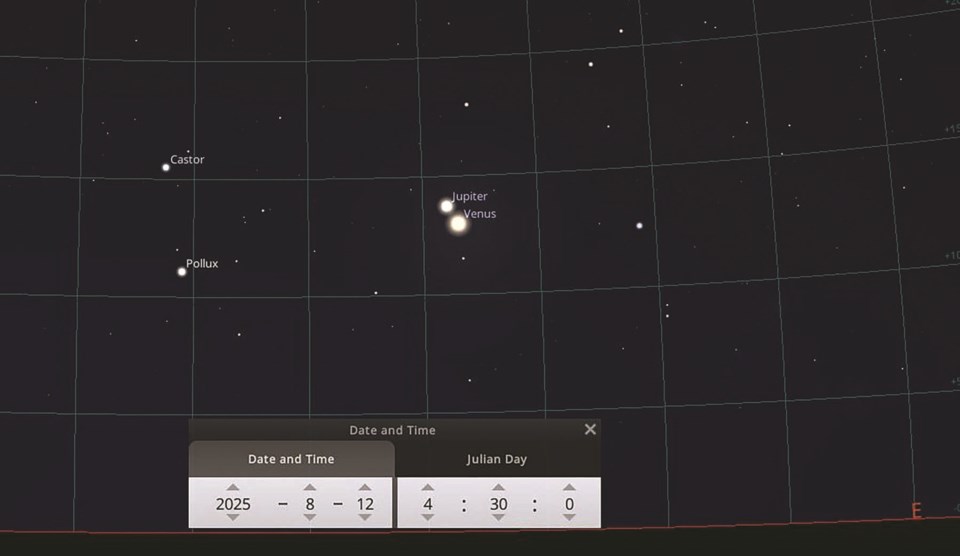It’s August and it’s time for the Perseid meteor shower. Yes, it’s one of the most popular and best-known meteor showers, as far as I can tell mostly because of our August weather: it’s warm enough to lie around outside comfortably and we’re less likely to be looking up at 20,000 feet of overcast. We can expect 50+ meteors per hour at the peak, which occurs Aug.12 at 07:00 our time –– in daylight, unfortunately. However, the Perseids peak is spread out a couple of days on either side, so our best window is Aug. 10 through 14. The meteors will appear to radiate from a point in Perseus, a constellation well up in the NE after 22:00. Regrettably, the full Moon occurs early Aug. 9 and moonrise occurs from 21:30 to 22:40 over the window of Aug. 10 to 14. While the Moon will wash out some of the fainter meteors, the Perseids are generally fast and bright so it‘s still worth the effort to watch them.
The Perseids are also a mostly northern hemisphere display –– Perseus is not too far away from Polaris –– so we shouldn’t have to wait until after solar midnight to really see the meteors’ full stream. In general, it helps to be on the leading side of Earth as it orbits the Sun if you expect to see the stuff we run into but in this case, they’re running into us from the north.
The Perseid meteors arise as debris from Comet Swift–Tuttle, discovered in 1862 by Lewis Swift and Horace Tuttle. Its orbit goes just a bit farther out than Pluto (aphelion) and its closest approach (perihelion) is just inside Earth’s orbit. It is also a large comet with an apparent diameter of 16 miles and is definitely the largest near-Earth object to make close crossings of Earth’s orbit. That’s considerably bigger than whatever it was that is presumed to have landed offshore Mexico’s Yucatan peninsula 66 million years ago. However, Wikipedia assures us that there is zero chance of an impact, at least for the next 2,000 years. That makes me feel much better. I guess.
Another treat for August occurs in the east before sunrise. After its June 24 conjunction with the Sun, Jupiter is in Gemini, to the right of the pair of stars, Castor on top and Pollux below. Venus, meanwhile, has passed its greatest western elongation and is heading around to pass behind the Sun while Jupiter is slowly moving east towards Pollux. The two planets pass less than one degree from each other at about 04:30 on Aug. 12 about 13 degrees above the ENE horizon; the obvious motion of Venus as it passes Jupiter is really impressive, especially to kids. The attached screenshot is of the Aug. 12 close approach.
From Aug. 12, the same morning as the Venus-Jupiter conjunction, you’ll begin to see a decent appearance of Mercury which should last until the end of the month. It will move daily up and right towards Venus until Aug. 19 when it starts to retreat down and left. On Aug. 21, it will be passed by a waning sliver of the Moon but will be visible less than ten degrees above the ENE horizon for all of August.
Referring to the last two months’ features on Uranus and Neptune, be assured they’re still right there –– Uranus below and right of the Pleiades and Neptune just above Saturn. When they’re that far out, they’re not going anywhere quickly, after all. Remember, Stellarium is a free download and with a little practice you’ll have a free model of the universe on your computer. Add a pair of binoculars and you too can see our outermost planets and amaze all your friends. If they’re not impressed, perhaps you need new friends.
The SCAC monthly meetings will resume in September and will be held at the Sechelt Library at 7 p.m. the second Friday of each month. Details for the next meeting and ongoing observatory openings should be available on the club website at: sunshinecoastastronomy.wordpress.com.



